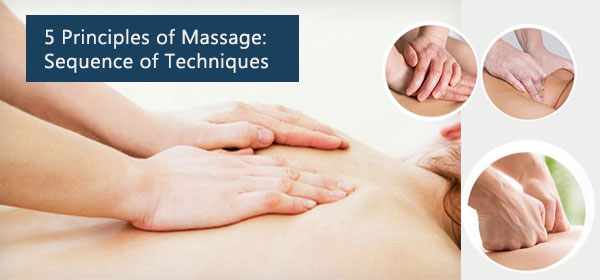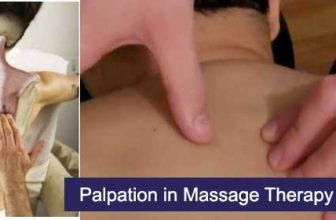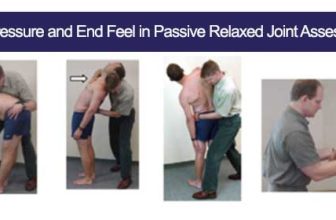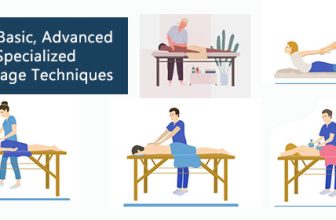
Sequence of Massage Techniques
Massage therapy sequencing is guided by a set of fundamental principles aimed at optimizing therapeutic outcomes and promoting holistic well-being. It involves the use of of Swedish and non-Swedish techniques, seamlessly transitioning from one to another as the therapist fluidly moves through different parts of the body. These principles not only dictate the direction and progression of manipulation but also ensure that each technique complements the next, creating a cohesive experience for the client.
The general sequencing principles that guide the application of massage techniques are as follows:
General ➜ Specific ➜ General
This principle outlines the systematic progression of massage techniques from general to specific areas of the body and then back to more general strokes. It involves starting with broader strokes or techniques applied across larger areas of the body before targeting specific muscles or areas of tension, and then concluding with broader strokes again.
Example: Effleurage, a general stroking technique, is initially applied across the entire back to warm up the tissues and acclimate the client to the therapist’s touch. Subsequently, the therapist may focus on specific muscles like the erector spinae or trapezius. Finally, the series ends with more general strokes to promote relaxation and integration of the targeted work.
The purpose of this sequence is multifaceted. It serves to gradually warm up the tissues, increasing blood flow and flexibility while also familiarizing the client with the therapist’s touch. Beginning with broader strokes allows the therapist to assess the client’s response to pressure and palpate through layers of tissue in a systematic manner. Moreover, initiating with general techniques can help reduce post-treatment soreness or kickback pain by adequately preparing the tissues for deeper work.
Superficial ➜ Deep ➜ Superficial
This principle outlines the progression of massage techniques from superficial to deeper layers of tissue and then back to superficial layers. It involves starting with techniques that affect the surface layers of muscles and skin, then gradually penetrating deeper into the muscle tissue, and finally returning to superficial techniques.
Example: Beginning with superficial techniques such as effleurage over the trapezius muscles helps to relax surface tension and prepare the area for deeper work. Following this, the therapist may target deeper muscles like the rhomboids using techniques such as petrissage or trigger point therapy to address specific areas of tension or dysfunction. Finally, the series of techniques conclude with superficial strokes again to promote relaxation and circulation.
This sequencing strategy is designed to ensure that deeper work is preceded by adequate preparation and warming up of the superficial tissues, reducing discomfort and risk of injury. By starting superficially, the therapist can gauge the client’s tolerance and response to pressure before progressing to deeper techniques. Additionally, returning to superficial strokes at the end of the session helps to integrate the deeper work and promote overall relaxation.
Proximal ➜ Distal ➜ Proximal
This principle is particularly relevant when addressing the limbs and other body parts outside of the torso or trunk. It involves starting treatment closer to the core of the body (proximal), progressing towards the extremities (distal), and then returning to the proximal areas.
Example: Before addressing specific issues in the forearms, it’s essential to begin with the upper limbs. Starting with techniques applied to the shoulders and upper arms allows for the release of tension and restriction in the proximal tissues, which in turn facilitates more efficient venous and lymphatic return from the distal parts of the arms.
By following this sequence, therapists can ensure comprehensive treatment by addressing any proximal issues that may contribute to or exacerbate distal problems. Furthermore, beginning treatment proximally allows for a more holistic approach, considering the interconnectedness of different areas of the body.
Peripheral ➜ Central ➜ Peripheral
This principle is particularly useful when treating acute or subacute local injuries, as well as scar tissue. It involves starting treatment at the periphery of the affected area, then progressing towards the central region, and finally returning to the periphery.
Example: When treating an acute injury or scar tissue, beginning with techniques applied to the peripheral tissues surrounding the affected area allows the therapist to promote lymphatic circulation that remove waste products resulting from the inflammatory process. Additionally, scar tissue at the periphery is often less adhered and easier to break down.
After addressing peripheral restrictions, the therapist can then progress towards the central affected area, applying techniques to release deeper tension and promote healing. Finally, returning to the peripheral tissues allows for integration of the central work and ensures comprehensive treatment of the entire affected area.
This sequence is beneficial as it allows for a systematic approach to addressing acute injuries and scar tissue, ensuring that peripheral issues are resolved before progressing towards the central area. This approach also aids in minimizing discomfort for the client, as it avoids immediate invasive treatment of central areas of pain and apprehension. By following this principle, therapists can effectively manage inflammation, promote tissue healing, and restore function.
Treating the Antagonist
This principle emphasizes the importance of addressing both the agonist and antagonist muscles in a muscle pair to achieve balance and optimal function. The agonist is the muscle primarily responsible for a movement, while the antagonist opposes the action of the agonist. Neglecting to treat the antagonist can lead to overlooked sources of dysfunction and hinder the effectiveness of treatment.
Example: Consider a client experiencing lower back pain due to trigger points in the gluteus maximus muscles. While it may seem enough to focus solely on treating the affected muscles, overlooking the antagonist muscles can perpetuate the issue. In this case, a shortened hip flexor (such as the psoas muscle) can contribute to anterior pelvic tilt, which in turn increases tension and activates latent trigger points in the gluteus maximus . Therefore, addressing both the gluteus maximus and its antagonist, the hip flexors, is crucial for restoring balance and relieving lower back pain.
By incorporating this principle into massage therapy, therapists can address imbalances between muscle pairs, promote symmetry and alignment, and prevent compensatory patterns that contribute to pain and dysfunction. Treating both the agonist and antagonist muscles ensures a comprehensive approach to musculoskeletal health, leading to improved outcomes for clients.



